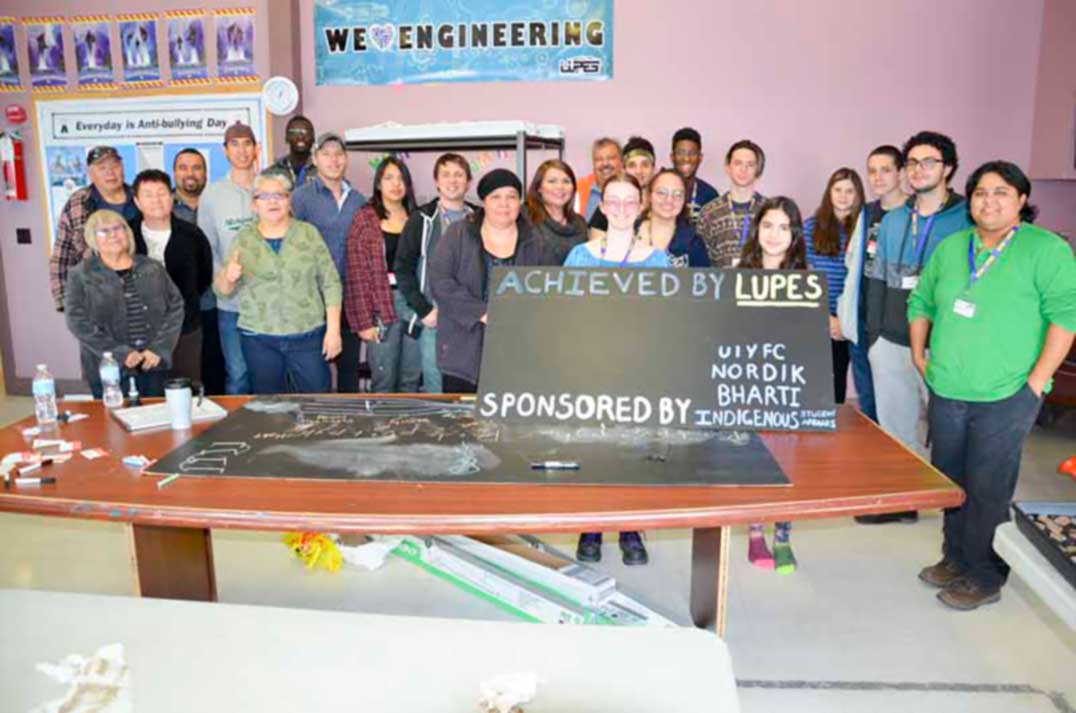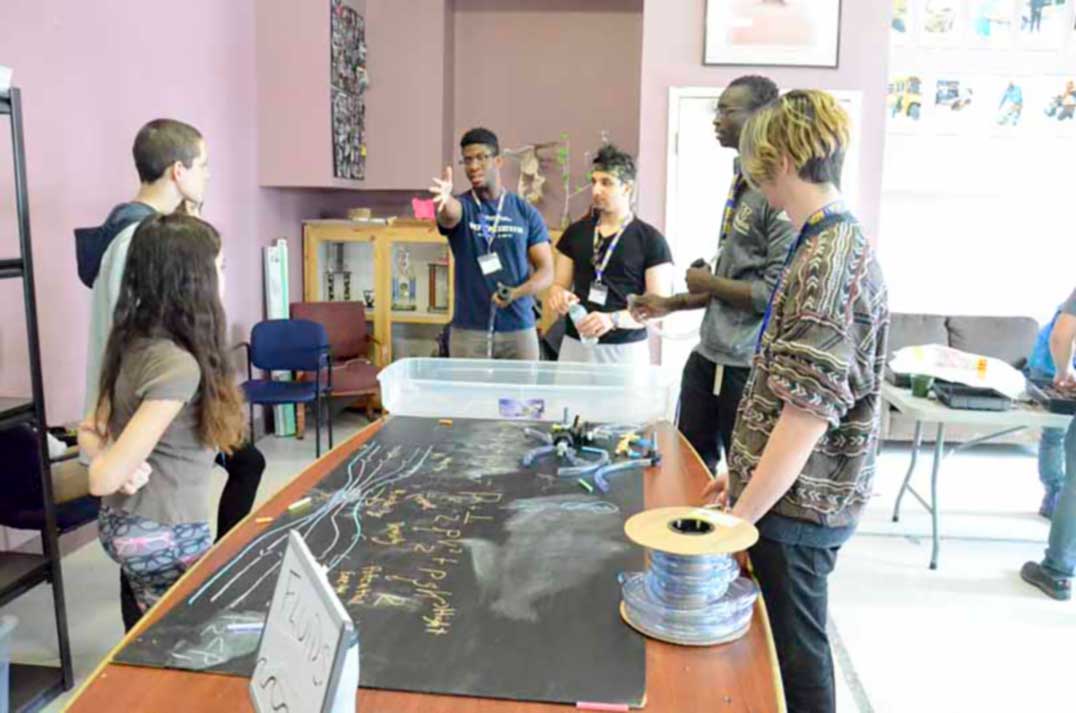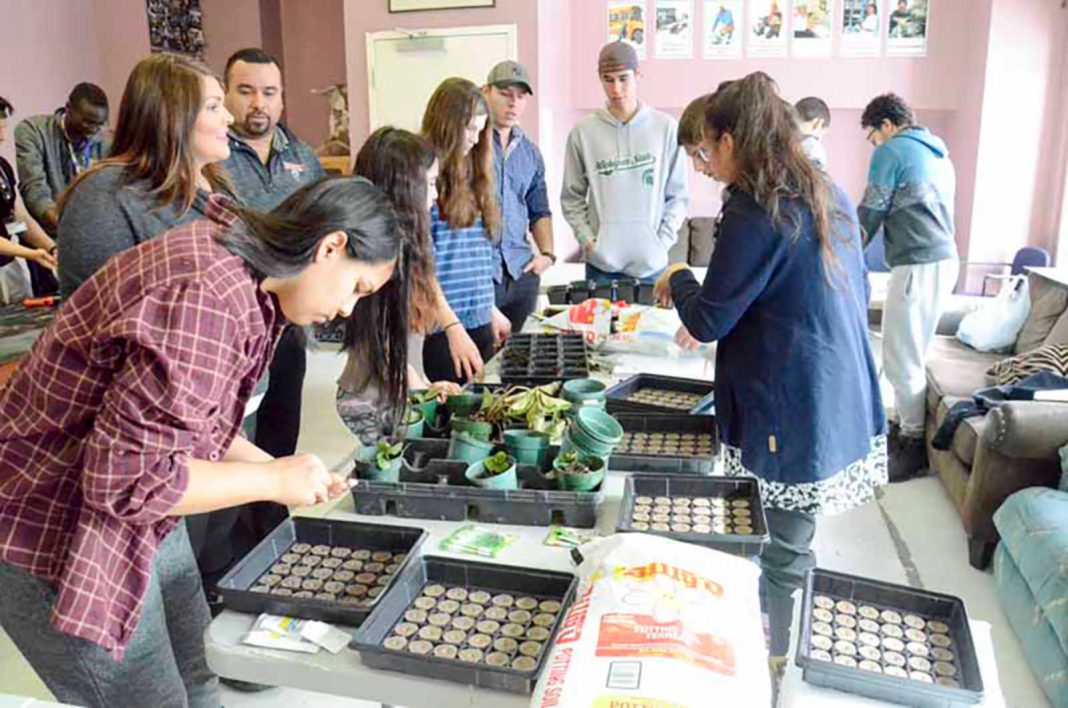Student volunteers from the Laurentian University Project Engineers Society work with youth on ‘green wall’ project
WIIKWEMKOONG—In the battle to capture the hearts and minds of Anishinabe youth for maths and sciences, a stalwart group of Laurentian University engineering students scored a signal victory this past weekend at the Wasse Nabin Youth Centre with an innovative green wall project.
Engineering student Kaella Earle, president of the Laurentian University Project Engineering Society (LUPES) and a Wiikwemkoong band member, brought her engineering colleagues to the youth centre to share their passion for problem solving that lies at the heart of the true engineer.
LUPES, she explained, differs from many other engineering groups of students in that its primary goals are not “social” in aspect. No pub crawling bus tours seeking to drink the bar dry in this crew—it’s all about community engagement. Not that they don’t enjoy a bit of fun, they just find theirs along a different path.
When LUPES was casting about for this year’s project they explored a number of ideas before settling on the green wall concept. “It was (LUPES) vice president Shane Pennant who came up with the idea after I mentioned community gardens,” said Ms. Earle.

Wiikwemkoong to celebrate the completion of their green wall project.
photo by Michael Erskine
Utilizing their knowledge of science and engineering, the LUPES project team designed a project that would incorporate traditional plants and medicines in a sustainable nurturing project to incubate the plants during the colder months and brought that project to the youth centre to share with interested students.
As a means of introduction, each of the engineering students (who hail from different streams of their discipline) volunteered their favourite subjects—and surprisingly not all of those subjects were math and science (although quite a few were). Liam Klemm admitted to a love of home projects, Juac Aguer is fascinated with the building of prototypes. Shane Pennant’s secret passion is comic books and science fiction while Patricia Winfield is engaged in “a lot of artistic stuff.”
“Even though we are all in engineering, you don’t have to be perfect at everything to like engineering,” said Ms. Earle. “I myself find math very challenging.”
The key to the soul of most engineers, she shared, is a drive “to make life easier for people—creating things and making ideas a reality.” The discipline helps its adherents to “do things in a different way, it doesn’t have to necessarily be ‘science’.”
“That is the mindset of an engineer,” she said. “Problem solving; if there is a problem in the world how do we fix it?”

Ms. Earle went on to outline the engineering process LUPES follows in approaching problem solving. “First, there is identification. What problem exists in the world (that) we can tackle? If something is not working, how can we make it better? We have to identify the problem.”
Second is the initiation stage. “After you figure out what the problem is, you find out all you can about what the problem actually is,” she said. By investigating the problem, you may find its root causes are different than they seemed at first blush.
The third stage follows the identification of the problem and the collection of information. “You define the priorities in how you work,” said Ms. Earle. “You have to work together with the people being affected by the problem. You can’t fix it in spite of how it effects other people.” In this phase, you determine what you can and can’t do as you approach the problem.
The last two phases are execution and the closeout.
“Execution is what we are doing here today,” said Ms. Earle. “We are building a green wall to house and nurture these plants.”
When engineers complete a project, they sign off on it, appending their signatures to the final product. “When we are finished here today,” she explained to the youth; “you will be signing off on the project along with us. That is one of the satisfying things, you sign off on what you have done. When we are finished here today, you will have completed your first engineering project.”
With that, the youth and engineers rolled up their sleeves and dug into the project, literally, as they planted and transplanted the seeds and plants that would form the green wall. Engineering can be a dirty job, but judging by the focus of those engaged in this execution phase, it can be lots of fun too.
Strawberries, tobacco, sage, mint and rosemary were among the plants the youth planted in peat pods and as they worked, the engineers explained some of the rationale behind where the plants would sit in the green wall. “Mint is very aggressive,” explained Liam Klem, “so lots of people tend to plant it in pots.” Tobacco, on the other hand, found itself somewhat isolated from the other plants as it tends to be toxic to its close neighbours.
The project was slated to be completed by noon, when the group broke for lunch, but the best laid plans of even engineers “gang aft agley” as the poet said. “The planting took a little longer than we planned,” admitted Ms. Earle with a smile. Engineering lessons come with every execution phase. Undaunted, the team pushed on following lunch.
As lunchtime neared, a group of elders, many of them family members of Ms. Earle’s came in to see how things were progressing. They were greeted with the sight of a small group of youth totally engrossed in the building of the green wall, so focussed on what they were doing they barely noticed the new arrivals.
Wasse Nabin Youth Centre director Lawrence Enosse was well pleased with the project and the way the students were so engaged.
It’s interesting to note, that while engineering still tends to be a male-centric occupation, three of the nine LUPES members at the green wall project were women and 75 percent of the youth attending were Anishinabekwe. Times they are a-changing.



